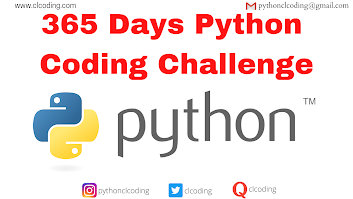Tuesday, 29 March 2022
random: Python has a built-in module that you can use to make random numbers.The random module has a set of methods:random(): Returns a random float number between 0 and 1sample(): Returns a given sample of a sequenceshuffle(): Takes a sequence and returns the sequence in a random orderchoice(): Returns a random element from the given...
Friday, 25 March 2022
Sequence Matcher in Python
Python Coding March 25, 2022 Python No comments

#!/usr/bin/env python# coding: utf-8# # Sequence Matcher in Python# In[3]:from difflib import SequenceMatchertext1 = input("Enter 1st sentence : ") text2 = input("Enter 2nd sentence : ")sequenceScore = SequenceMatcher(None, text1,...
Age Calculator using Python
Python Coding March 25, 2022 Python No comments
Saturday, 19 March 2022
Image to Pencil Sketch in Python
Python Coding March 19, 2022 Python No comments

#!/usr/bin/env python# coding: utf-8# # Image to Pencil Sketch in Python # In[ ]:#...........Convert image to pencil sketch......!import cv2#specify the path to image (Loading image image)image1 = cv2.imread('E:\demo.png')window_name =...
Sunday, 13 March 2022
Voice Recorder in Python
Python Coding March 13, 2022 Python No comments

#!/usr/bin/env python# coding: utf-8# In[13]:pip install sounddevice# In[14]:pip install scipy# # Voice Recorder in Python# In[15]:#import required modulesimport sounddevicefrom scipy.io.wavfile import write#sample_ratefs=44100#Ask to enter...
Download YouTube videos in Python
Python Coding March 13, 2022 Python No comments

#!/usr/bin/env python# coding: utf-8# # Download YouTube videos in Python# In[1]:pip install pytube# In[1]:#import pytube library to download the videoimport pytube#Ask for the url of videourl = input("Enter video url: ")#we can take path as...
Captcha in Python
Python Coding March 13, 2022 Python No comments

#!/usr/bin/env python# coding: utf-8# In[1]:pip install captcha# # Generate Image captcha in python:# In[12]:from captcha.image import ImageCaptcha # Specify the image sizeimage = ImageCaptcha(width = 300, height = 100)# Specify...
Secrets Python module
Python Coding March 13, 2022 Python No comments

#!/usr/bin/env python# coding: utf-8# # secrets.randbelow(n): This function returns a random integer in the range [0, n)# In[1]:import secrets passwd = secrets.randbelow(100)print(passwd)# # secrets.randbits(k): This function returns...
Saturday, 5 March 2022
Mouse and keyboard automation using Python
Python Coding March 05, 2022 Python No comments

#!/usr/bin/env python# coding: utf-8# # Mouse and keyboard automation using Python# In[31]:import pyautoguiprint(pyautogui.size())# In[32]:#moveTo(): use this function to move the mouse in pyautogui module. pyautogui.moveTo(100, 100, duration...
Friday, 4 March 2022
Python Secrets Module
Python Coding March 04, 2022 Python No comments

#!/usr/bin/env python# coding: utf-8# # secrets.randbelow(n): This function returns a random integer in the range [0, n)# In[16]:import secrets passwd = secrets.randbelow(100)print(passwd)# # secrets.randbits(k): This function returns...
Popular Posts
-
In a world increasingly shaped by data, the demand for professionals who can make sense of it has never been higher. Businesses, governmen...
-
Let's break down the code step by step: marks = 75 This line assigns the value 75 to the variable marks. It represents a student'...
-
Let me explain this code: num = 1 while num < 6: print(num) This code has a few issues that would cause it to run indefinitely (inf...
-
Let's break down this Python for loop: for i in range ( 0 , - 2 , - 2 ): print(i) range(start, stop, step) parameters: start =...
-
Python code line by line: import array as arr This imports Python's built-in array module and gives it the alias arr. The array...
-
Explanation: lambda a, b: a + b + 1 is an anonymous function that takes two inputs, a and b. It returns the result of a + b + 1. No...
-
Introduction to Data Science in Python: Course Review and Insights Python has become one of the most powerful and popular programming lang...
-
Step-by-step Explanation: Initialize an empty list funcs: funcs = [] This is just creating an empty list, where functions will be stored. ...
-
What you'll learn Describe what data science and machine learning are, their applications & use cases, and various types of tasks ...
-
Fundamentals of Digital Image and Video Processing In today's visually-driven world, digital images and videos are everywhere—from the...
Categories
100 Python Programs for Beginner
(109)
AI
(41)
Android
(24)
AngularJS
(1)
Api
(2)
Assembly Language
(2)
aws
(17)
Azure
(7)
BI
(10)
book
(4)
Books
(200)
C
(77)
C#
(12)
C++
(83)
Course
(67)
Coursera
(253)
Cybersecurity
(25)
Data Analysis
(3)
Data Analytics
(4)
data management
(11)
Data Science
(149)
Data Strucures
(8)
Deep Learning
(21)
Django
(16)
Downloads
(3)
edx
(2)
Engineering
(14)
Euron
(29)
Events
(6)
Excel
(13)
Factorial
(1)
Finance
(6)
flask
(3)
flutter
(1)
FPL
(17)
Generative AI
(11)
Google
(38)
Hadoop
(3)
HTML Quiz
(1)
HTML&CSS
(47)
IBM
(30)
IoT
(1)
IS
(25)
Java
(93)
Java quiz
(1)
Leet Code
(4)
Machine Learning
(86)
Meta
(22)
MICHIGAN
(5)
microsoft
(4)
Nvidia
(4)
Pandas
(4)
PHP
(20)
Projects
(29)
pyth
(1)
Python
(1067)
Python Coding Challenge
(465)
Python Quiz
(138)
Python Tips
(5)
Questions
(2)
R
(70)
React
(6)
Scripting
(3)
security
(3)
Selenium Webdriver
(4)
Software
(17)
SQL
(42)
UX Research
(1)
web application
(8)
Web development
(4)
web scraping
(2)




.png)




.png)







.jpg)







.png)








.png)








